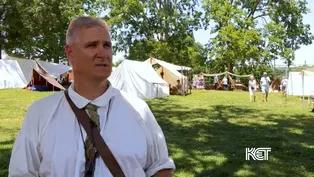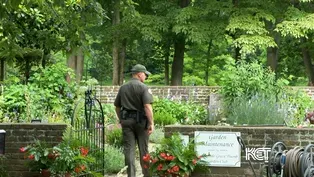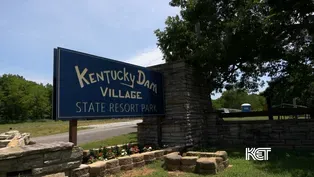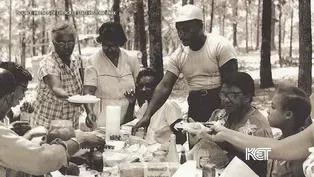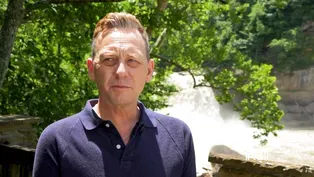
Pine Mountain State Park
Clip: Season 3 Episode 25 | 3m 53sVideo has Closed Captions
Pine Mountain State Park is often referred to as Kentucky's first state park.
Often referred to as Kentucky's first state park, Pine Mountain State Park is home to some of the state's biggest natural and man-made attractions.
Problems with Closed Captions? Closed Captioning Feedback
Problems with Closed Captions? Closed Captioning Feedback
Kentucky Edition is a local public television program presented by KET

Pine Mountain State Park
Clip: Season 3 Episode 25 | 3m 53sVideo has Closed Captions
Often referred to as Kentucky's first state park, Pine Mountain State Park is home to some of the state's biggest natural and man-made attractions.
Problems with Closed Captions? Closed Captioning Feedback
How to Watch Kentucky Edition
Kentucky Edition is available to stream on pbs.org and the free PBS App, available on iPhone, Apple TV, Android TV, Android smartphones, Amazon Fire TV, Amazon Fire Tablet, Roku, Samsung Smart TV, and Vizio.
Providing Support for PBS.org
Learn Moreabout PBS online sponsorshipPine Mountain State Park, also one of the original four opened in 1924, which is why it's often referred to as Kentucky's first state park.
The park is home to some of the state's biggest natural and manmade attractions.
There's many different layers of history here at the park.
This park was home to the Cherokee and the Shawnee.
They said that between 17, 18, 1810, we had about 310,000 settlers that passed out through here on foot or horseback.
One eighth of the nation's population can still trace an ancestor to right here.
This park was set aside by our state geologist, Willard Ralph Jillson, and he's a guy who doesn't get nearly the attention that I think he should because he did so much for the tourism of our state.
He got a job as the state geologist under Augustus Owsley.
And this is right on the heels of the birth of the National Park Service in 1916.
And so he tasked Jillson with finding what he thought would be the four best places for state parks.
Here we are 100 years later, enjoying that same place that Jillson wanted to protect.
This park is nestled here in Bell County.
We have in Bell County 44 of 148 rare and endangered plants in the state.
So if you're into botany, you're into wildflowers.
We've got you.
We have tons of wildlife, turkeys and bobcats and deer and bear.
And, you know, it's so awesome to be able to stand in, say, somewhat garden and maybe second grow forest.
That seems to be sort of the way that it was.
See those towering trees, you know, too, for it to be kind of dim in the daylight and places, you know, to get sort of that experience the way they described when Boone came through.
We do have some old growth forest here in southeastern Kentucky, you know, Lily Coronet Woods, Blanton Forest.
And they exemplify that maybe a little better.
But here I think the access is a little easier to see some really awesome stuff, some three or 400 year old trees.
Laurel Cove, the trail and the amphitheater both are must see, I think they're some of the prettiest places in eastern Kentucky.
Of course, our most popular destination is chained rock.
Chained rock itself is a tourist trap.
And I've been on camera and I've said it a million times to groups, but I've always made the argument that it is the world's best tourist trap because it's the only one that you get to and you're not disappointed with.
When you get to chain rock, you have this beautiful 270 degree view.
You're able to look down and see the path of those 310,000 settlers.
You can see the spot where Thomas Walker named the river.
In the community, we try to be as involved as we can.
We do close to 100 school groups a year in some capacity, and we try to do as many free things for kids as we can through the year.
And we want to expose them to all of this.
We want them to see the natural and see why it's important.
Maybe learn why, why bats are great, why snakes are great, learn things that maybe in their normal day to day life they wouldn't have the exposure to.
I think that should be kind of our job as the state parks to explain to the kids why this is important.
Why do we want to protect it?
This year we're trying to promote 100 years of success and hope for 100 years more.
This park is special in my mind because of the history, the history of the people who built this park, the history of the people like Gillson, who built Kentucky state parks, who built the tourism industry, who began a push to protect natural lands in the state.
It only protects the natural lands of the first campsite of Dr. Thomas Walker.
It protects the Civil War encampment that was here.
It protects the Native American burial wells that are on the park.
It protects all of the different layers of history and preserves it for generations and generations to come.
I think without something like this in our local community, I think we'd be in much worse shape.
It's something that everyone should see and everyone should try to treasure and protect.
Video has Closed Captions
Keeping Old Fort Harrod's historical footprint intact. (2m 50s)
Video has Closed Captions
These park rangers have a passion for Kentucky's state parks. (2m 53s)
Video has Closed Captions
A state park in Western Kentucky is employing people in need of a second chance. (2m 53s)
Preserving Cherokee State Park
Video has Closed Captions
Cherokee State Park was the state's first, and only, park for African Americans. (5m 14s)
Writing Workshops at State Parks
Video has Closed Captions
Kentucky Powet Laureate Silas House is hosting writing workshops at state parks. (5m 33s)
Providing Support for PBS.org
Learn Moreabout PBS online sponsorshipSupport for PBS provided by:
Kentucky Edition is a local public television program presented by KET
